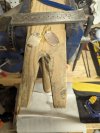Hurkules is a good brand. Pike Gold and Super Pike are also good. I use a #2 blade for 90% of all cutting.
Tip on learning to use a jeweler's saw:
Find some larger coins. $.50 or $1.00 size coins are good starters, but even $.25 size coins work. Pick one with an interesting image. Bahama's quarter with the marlin will work. If it has a figure that goes from top to bottom it is the best to start with. Full busts and heard are great, walking liberty figures, etc.
It can be any type metal.
Use a fine tip sharpie and draw a line around the figure and coin edge to how where you need to remove metal to make the coin into a framed pendant. You can blacken the areas you want to cut out if needed. Drill tiny holes in all the corners where you will insert a saw blade or turn a tight corner.
If you don't have one already, make a sawing board. It is a simple 5-6" bench pin that is level and has a narrow "V" slot cut in it. The apex of the V should be a roughly 1/2" hole. A piece of 2"X8"X1/2" hardwood is perfect. I like to round off the front corners and slightly taper the bottom side. Screw or clamp the sawing board to the bench or work table so it is around 36" off the floor level. This will allow comfortable sawing.
Place the saw blade in one end of the frame, slip the coin on the blade (top side away from handle), and put the other end in the frame. Place the end of the saw frame against the bench pin and press moderately on the handle with your chest. Tighten the blade clamp while the pressure is applied. A #0 or #1 blade is good for cutting out coins in the beginning. After you learn sawing, you can go down to a 2/0 blade if you need fine detail cuts.
Saw around the piece that needs to be removed until you cut out that section. Move the saw to the next section and repeat until all excess metal has been removed and the figure is in the center of a round frame. Lubricate the blade often, as needed.
When the blade starts to cut in a curve, change it! Don't worry about breaking blades, it is a fact of life when learning that you will go through dozens of blades until you learn to control the pull stroke without twisting the saw sideways and pinching the blade. Most folks use half the gross they bought on their first couple projects. Some never use up the rest once they learn how to saw.
Finish the rough-cut surfaces with a fine half-round jeweler's file.
I make these in old Standing Liberty silver coins and weld a jump ring on the top. You can also simply drill a hole for the bail ring near the top of the coin. They cost only the silver, they sell easily, the scarp pieces go back into the silver refinery can, and if the job doesn't look good, you can toss the whole project into the scrap can. Non-silver coins work just as good and are even cheaper. A Bahamas $.50 coin with the jumping marlin is a popular pendant and is very easy to make. You don't need a collector's grade coin. (Tip- connect the bill and the dorsal fin to the frame so it is supported. Saw out the area to each side of the marlin leaving the seas and fish.)


